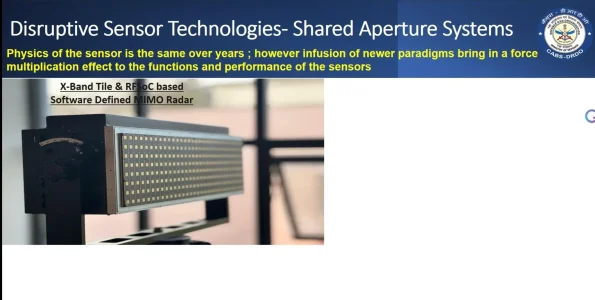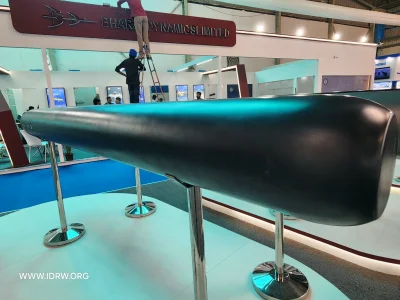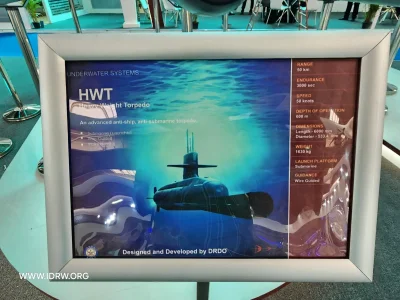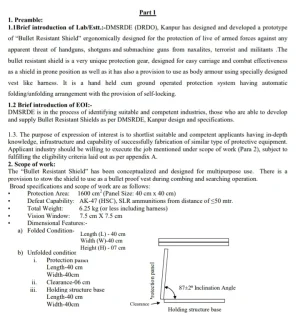It could be for short range air defense.What is the meaning of this 18 sec flight time? this is the first time I am seeing a metric like this for an ATGM.
DRDO and PSUs (22 Viewers)
- Thread starter 125mm_Smoothbore
- Start date
More options
Who Replied?- Joined
- Jul 2, 2024
- Messages
- 91
- Likes
- 1,296
I have to search for the dimensions.
But I have some charts and graphs showing the time of operation of 1st and 2nd pulse of Akash NG and the velocity achieved as a result.
In that graph, max distance travelled by the missile is shown as 50 km.
I firmly believe this is the max range. Let me find those charts.
Found 1 graph. Couldn't find the other.
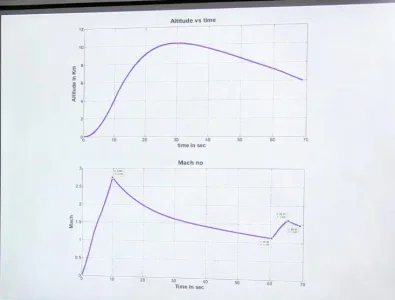
Peak speed reached is on burnout of 1st pulse motor. It's 2.75 M.
2nd pulse burnout results in a max v of around 1.6 M.
I firmly believe that the dart or 2nd stage in Kusha M1 is either a new missile which has close resemblance to Akash NG or another variant of Akash NG with higher energy propellants.
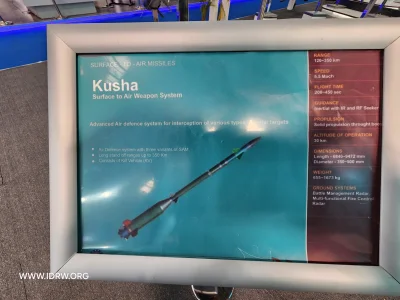
It's impossible for a 30-50 km range missile to have 120 km range with the addition of a booster.
The missile in the idea pic isn't Kusha M1. Look at the din arrangement on the booster. Besides the forebody control surfaces on the 2nd stage missile are much closer to the the radome than Akash NG. It's a different missile.
Now here's Kusha M1.
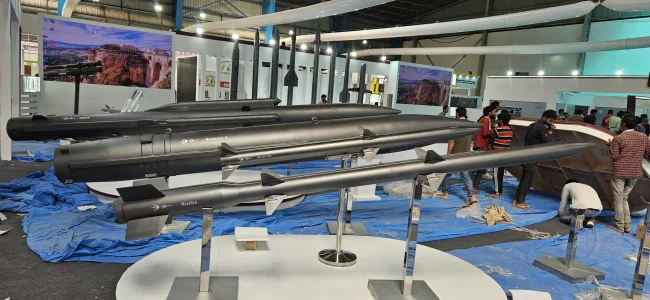
Now compare the missiles in the two pics. Both the booster and KV as DRDO calls it are different.
- Joined
- Jul 2, 2024
- Messages
- 1,414
- Likes
- 9,106
It's subsonic Dawg, would take an eternity to reach thereIt could be for short range air defense.
Anyways, here you go
Well swash plate is not something that you really need, it's more of a niche feature that comes at the cost of increase in weight, so it makes sense to not have one on AMCA and have it on Su-30MkIs instead.This doesn't appear to be on a swash plate unlike the Virupaksha for Su30mki. If so, will the upward angled position of the radar have any coverage issues? Or is the angle immaterial?
Also, a movable radar will interfere with the low RCS of the plane; more on that bit later
Well as for angle, there are two reasons for this.
The minor one being that by angling it bit upwards you increase the maximum altitude you can scan at the cost of a "blind spot" below you. But as the ground is way closer to you than the space above, this is not that significant
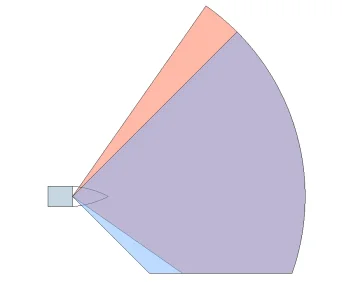
But the major reason here is that it's a stealth platform and you want the RCS to be as small as possible. The radome is "transparent" to an enemy radar, but he can see your radar because it's made up of metal and most importantly all the supporting loha-lakkad behind it like bulkhead and mountings are pure metal. So, everything is angled upwards matching the angles of other components like vertical stabilizer. This is also the reason a swash plate is avoided in stealth platform as its variable angle negates the overall low RCS of the aircraft
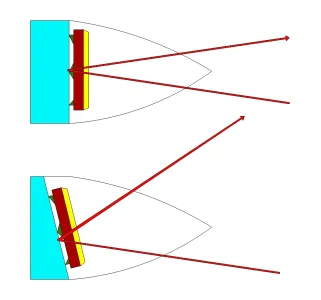
Ummnnn...are you sure that it's that only and not some mistranslation?
[ANTI] - (Missile Defence) can get mistranslated as {Anti-Missile Defence}
It's mentioned under AESA seeker so may be they are trying to say that this missile can defeat "Missile Defences" on ships using things like frequency hopping and LPI...hence Anti-Missile Defence
Just my guess
Seems Like upcoming Sukhoi GaN shall be the beast king for long time in IAF inventory. It even dwarfs AMCA radar.It's subsonic Dawg, would take an eternity to reach there
Anyways, here you go
1 5 3 6
View attachment 24727
Well swash plate is not something that you really need, it's more of a niche feature that comes at the cost of increase in weight, so it makes sense to not have one on AMCA and have it on Su-30MkIs instead.
Also, a movable radar will interfere with the low RCS of the plane; more on that bit later
Well as for angle, there are two reasons for this.
The minor one being that by angling it bit upwards you increase the maximum altitude you can scan at the cost of a "blind spot" below you. But as the ground is way closer to you than the space above, this is not that significant
View attachment 24728
But the major reason here is that it's a stealth platform and you want the RCS to be as small as possible. The radome is "transparent" to an enemy radar, but he can see your radar because it's made up of metal and most importantly all the supporting loha-lakkad behind it like bulkhead and mountings are pure metal. So, everything is angled upwards matching the angles of other components like vertical stabilizer. This is also the reason a swash plate is avoided in stealth platform as its variable angle negates the overall low RCS of the aircraft
View attachment 24729
Ummnnn...are you sure that it's that only and not some mistranslation?
[ANTI] - (Missile Defence) can get mistranslated as {Anti-Missile Defence}
It's mentioned under AESA seeker so may be they are trying to say that this missile can defeat "Missile Defences" on ships using things like frequency hopping and LPI...hence Anti-Missile Defence
Just my guess
- Joined
- Jul 6, 2024
- Messages
- 1,629
- Likes
- 4,527
What about using plasma to shield the radar when it's turned off, like ruskies use in some of their fightersIt's subsonic Dawg, would take an eternity to reach there
Anyways, here you go
1 5 3 6
View attachment 24727
Well swash plate is not something that you really need, it's more of a niche feature that comes at the cost of increase in weight, so it makes sense to not have one on AMCA and have it on Su-30MkIs instead.
Also, a movable radar will interfere with the low RCS of the plane; more on that bit later
Well as for angle, there are two reasons for this.
The minor one being that by angling it bit upwards you increase the maximum altitude you can scan at the cost of a "blind spot" below you. But as the ground is way closer to you than the space above, this is not that significant
View attachment 24728
But the major reason here is that it's a stealth platform and you want the RCS to be as small as possible. The radome is "transparent" to an enemy radar, but he can see your radar because it's made up of metal and most importantly all the supporting loha-lakkad behind it like bulkhead and mountings are pure metal. So, everything is angled upwards matching the angles of other components like vertical stabilizer. This is also the reason a swash plate is avoided in stealth platform as its variable angle negates the overall low RCS of the aircraft
View attachment 24729
Ummnnn...are you sure that it's that only and not some mistranslation?
[ANTI] - (Missile Defence) can get mistranslated as {Anti-Missile Defence}
It's mentioned under AESA seeker so may be they are trying to say that this missile can defeat "Missile Defences" on ships using things like frequency hopping and LPI...hence Anti-Missile Defence
Just my guess
- Joined
- Jul 2, 2024
- Messages
- 1,414
- Likes
- 9,106
Ayyyee bhakWhat about using plasma to shield the radar when it's turned off, like ruskies use in some of their fighters
How many times this plasma stealth bs needs to be debunked!?
- Joined
- Jul 6, 2024
- Messages
- 1,629
- Likes
- 4,527
I mean it has been used to mask" radar" by ruskies in some of their fighters.Ayyyee bhak
How many times this plasma stealth bs needs to be debunked!?
Not the entire jet, but the radar only inside the radome
- Joined
- Jun 30, 2024
- Messages
- 1,764
- Likes
- 22,571
@Ayan Barat
Cc @Arihant Roy
I made a mistake due to not factoring the context
It seems anti missile defence (ADM) is a ECM feature of the radar something like producing electronic clones of the AShM itself ie false targets to spoof RF seeker of hostile interceptors or other emitters
Cc @Arihant Roy
I made a mistake due to not factoring the context
It seems anti missile defence (ADM) is a ECM feature of the radar something like producing electronic clones of the AShM itself ie false targets to spoof RF seeker of hostile interceptors or other emitters
Last edited:
Can it also be mahindra and tata paying these media outlets to remind MOD what will happen if they buy strykers and don't buy indigenous.
Stryker infantry vehicle deal with U.S. progresses; Javelin missile to be demonstrated again
India considers procurement of Stryker infantry combat vehicles from the U.S. amid ongoing negotiations and defence deals.www.thehindu.com
Stryker infantry vehicle deal with U.S. progresses; Javelin missile to be demonstrated again
View attachment 24170
View attachment 24172
I am saying this because of the timing of these articles, they always come out when GOI meets US and they always quote unnamed sources.
These articles always quote that desi product has better performance than foreign one which is true but you won't find this in dalali articles.
It seems to me mahindra and tata are reminding PMO that buying strykers would not only entail finanical costs but also a huge political cost of not following through with atmarnirbhar bharat and make in india which are major political objectives.
Just a theory I am thinking because stryker has never been mentioned by GOI or any retired or serving soldier. It was always brought in discussion by US.
Last edited:
- Joined
- Jul 8, 2024
- Messages
- 1,954
- Likes
- 13,651
Plasma shielding works when something re-enters the atmosphere via the ionosphere layer.I mean it has been used to mask" radar" by ruskies in some of their fighters.
Not the entire jet, but the radar only inside the radome
This in effect creates a sort of Faraday Cage which prevents your radar from being useful for navigation.
In the article entitled "Radar cross sections of dielectric or plasma coated conducting spheres and circular cylinders" published by the IEEE Transactions on Antennas and Propagation, September 1963, the authors found that a dielectric (plasma) shell may either decrease or increase the echo area of the object. If either one of the two reflections is considerably greater, then the weaker reflection will not contribute much to the overall effect. The authors also stated that the EM signal that penetrates the plasma shell and reflects off the object's surface will drop in intensity while traveling through plasma
There is a reason why Hypersonic Glide Vehicles are crap at AShM roles due to a moving target and none of your radars being actually useful unless you use jugaad like the LRAShM which has a secondary booster to slow down the missile from > M 8.0 to M 2.0 - M 3.0 to get fresh targetting data and increased maneuverability at terminal stage.
- Joined
- Jun 30, 2024
- Messages
- 1,764
- Likes
- 22,571
- Joined
- Jul 2, 2024
- Messages
- 1,414
- Likes
- 9,106
Arre no issues Mate, it was a classic case of "eats shoots & leaves".@Ayan Barat
I made a mistake due to not factoring the context
Actually anti missile defence (ADM) is a ECM feature basically producing electronic clones of the AShM itself ie false targets to spoof RF seeker of hostile interceptors or other emitters
Therefore I deleted the post
They should have used "Counter Air Defence" but they didn't use cum and that's already way more than what we can ask them
But I've something else to discuss. There's a lot of chatter going on everywhere regarding the maneuver of guided Pinaka; some are saying it's a malfunction and some opinions are that it's bleeding energy. Was already doodling for radar angle so thought of doing this too
1. This is the quintessential ballistic trajectory followed by all unguided artillery.
And there's a WLR near the target

2. But only we can see this as a far standing observers; the small Weapon Locating Radar see just a small arc of this whole trajectory because of its limited range and more effectively the curvature of the Earth.
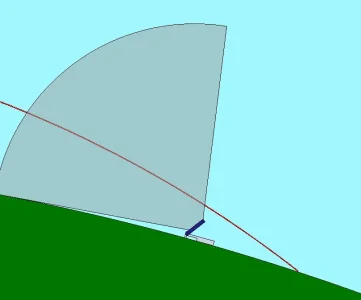
By taking multiple position reading at fixed time intervals this radar can pretty accurately calculate the position from where this projectile came and direct counter battery fire on that cordinate.
3. In guided rocket, the rocket does a weird little electric boogaloo just after launch and then continues its usual ballistic trajectory
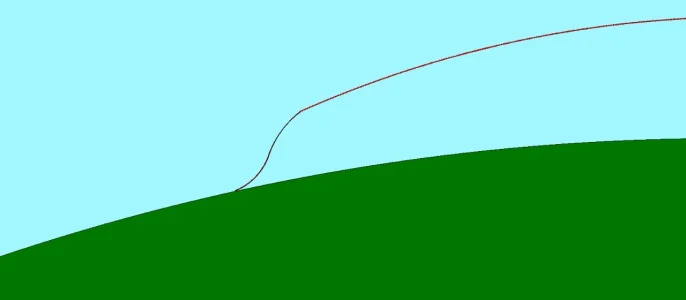
4. But the problem is that this is happening some 60-80km away from that WLR so it's pretty much all hidden behind the curvature of the Earth. For that WLR the projectile is still pretty much like this only

5. It again back tracks the launch point and direct counter battery fire on it. And this is where it starts getting interesting because for WLR it was typical Newtonian ballistic trajectory when in reality it was a modified one...so the counter battery fire lands few kilometres away from your position. This deviation makes shoot-n-scoot even more effective.

This is one very groundbreaking feature that was conceptualized by the HIMARS system. I'm pretty sure what we're seeing on the Pinaka is pretty much this
Your Diagram only talks about Pinaka's Maneuver in XY axis. But did you take into account its maneuver in Z axis at fag end of video? That maneuver is going to confuse the hell WLR.Arre no issues Mate, it was a classic case of "eats shoots & leaves".
They should have used "Counter Air Defence" but they didn't use cum and that's already way more than what we can ask them
But I've something else to discuss. There's a lot of chatter going on everywhere regarding the maneuver of guided Pinaka; some are saying it's a malfunction and some opinions are that it's bleeding energy. Was already doodling for radar angle so thought of doing this too
1. This is the quintessential ballistic trajectory followed by all unguided artillery.
And there's a WLR near the target
View attachment 24740
2. But only we can see this as a far standing observers; the small Weapon Locating Radar see just a small arc of this whole trajectory because of its limited range and more effectively the curvature of the Earth.
View attachment 24741
By taking multiple position reading at fixed time intervals this radar can pretty accurately calculate the position from where this projectile came and direct counter battery fire on that cordinate.
3. In guided rocket, the rocket does a weird little electric boogaloo just after launch and then continues its usual ballistic trajectory
View attachment 24742
4. But the problem is that this is happening some 60-80km away from that WLR so it's pretty much all hidden behind the curvature of the Earth. For that WLR the projectile is still pretty much like this only
View attachment 24741
5. It again back tracks the launch point and direct counter battery fire on it. And this is where it starts getting interesting because for WLR it was typical Newtonian ballistic trajectory when in reality it was a modified one...so the counter battery fire lands few kilometres away from your position. This deviation makes shoot-n-scoot even more effective.
View attachment 24743
This is one very groundbreaking feature that was conceptualized by the HIMARS system. I'm pretty sure what we're seeing on the Pinaka is pretty much this
- Joined
- Jul 2, 2024
- Messages
- 1,414
- Likes
- 9,106
And did you take in account that this 2D drawing itself is too much for my poor MS-Paint?Your Diagram only talks about Pinaka's Maneuver in XY axis. But did you take into account its maneuver in Z axis at fag end of video? That maneuver is going to confuse the hell WLR.
Hurrr Badbakk - You have already shown Good Paper drooling skills. - you should have used thatAnd did you take in account that this 2D drawing itself is too much for my poor MS-Paint?
- Joined
- Jul 6, 2024
- Messages
- 1,629
- Likes
- 4,527
It was used when "radar was off".Plasma shielding works when something re-enters the atmosphere via the ionosphere layer.
This in effect creates a sort of Faraday Cage which prevents your radar from being useful for navigation.
There is a reason why Hypersonic Glide Vehicles are crap at AShM roles due to a moving target and none of your radars being actually useful unless you use jugaad like the LRAShM which has a secondary booster to slow down the missile from > M 8.0 to M 2.0 - M 3.0 to get fresh targetting data and increased maneuverability at terminal stage.
- Joined
- Jun 30, 2024
- Messages
- 1,764
- Likes
- 22,571
- Joined
- Jun 30, 2024
- Messages
- 1,764
- Likes
- 22,571
Similar threads
Latest Replies
-
Operation Sindoor and Aftermath
- IRDefense
-
AMCA - Advanced Medium Combat Aircraft
- Brood Father
-
Indian Economy
- Azaad
-
Idiotic Musings from the West
- Oldworld
-
Russian Ukrainian War
- Soldier35
-
Hindu Persecution Watch
- Vinash
-
Israel x Iran Conflict
- MasterChief_949



